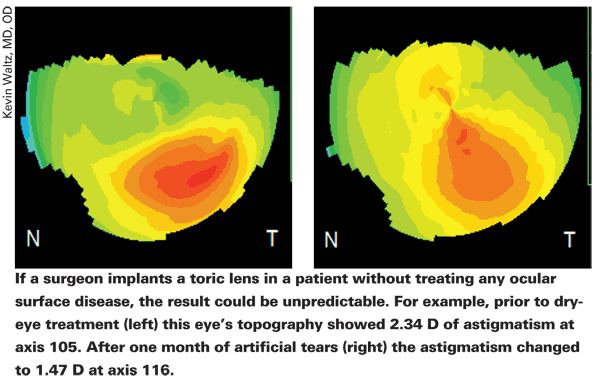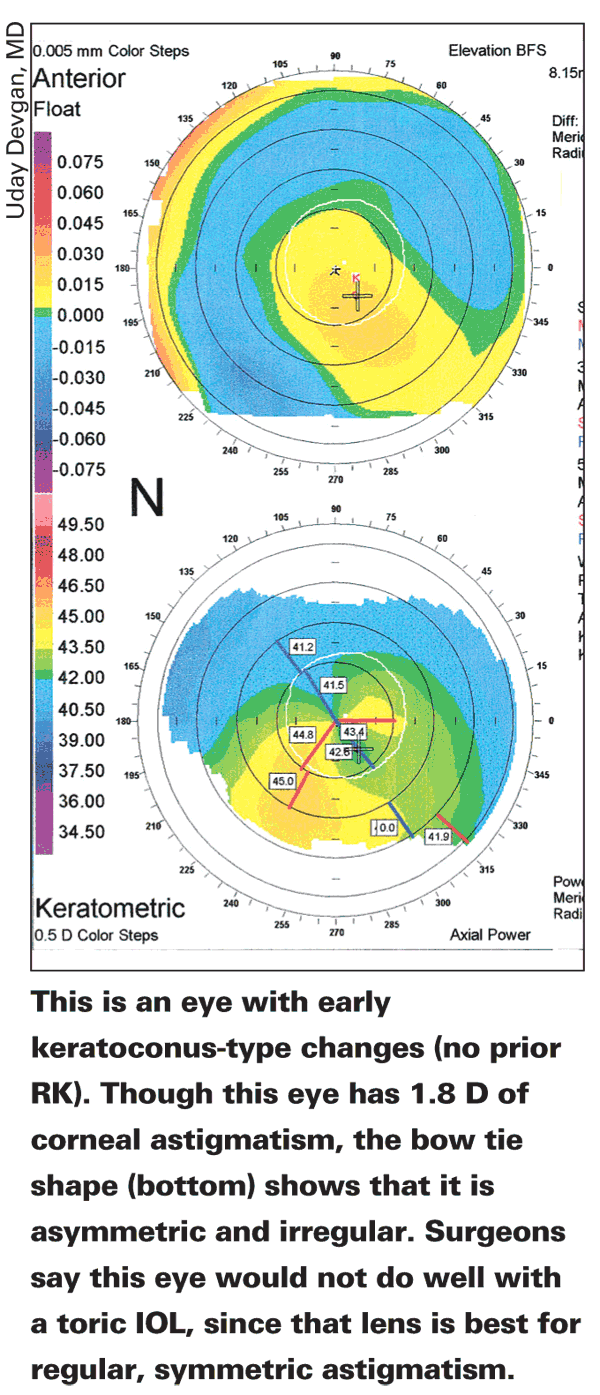Implanting presbyopic lenses in such a way that the patient gets the lenses' full effect is a challenging proposition in itself, since all of the surgical steps, from preop to postop, have to go almost perfectly. However, there's an additional layer of difficulty when the patient has a pre-existing condition or some other confounding factor that tests the surgeon's ability to get the best effect from the lens, such as ocular surface disease or previous hyperopic LASIK. In this article, several experts give their advice on how you can approach these more challenging cases.
Intraocular Issues
Patients can either present with anatomical problems, such as weak zonules, or can develop them on the operating table, as in the case of a damaged capsular bag. Here's how surgeons say they respond.
"Certain lenses have to go in the capsular bag," notes
"The Crystalens needs to go in the bag because of the way it's structured," Dr. Devgan continues. "It has to be posteriorly vaulted, and it needs to be in the bag to get that vault. If you put it partway in the bag and partway out, that's when you'll get the Z-syndrome, when the lens becomes twisted."
Indianapolis
However, it's not cut-and-dried, and some surgeons may wish to avoid possible problems altogether by not implanting the premium lens in patients with zonular problems. "I wouldn't implant one in such a patient," says
"If patients have any sort of macular disease, I don't want to implant a multifocal," says Dr. Devgan. "It could make the vision worse, as the two factors, the disease and the multifocal lens, will decrease contrast sensitivity. Also, any glaucoma, significant epiretinal membrane, macular pucker or hole, or macular degeneration will also make me think twice about implanting a multifocal. However, you can implant an Alcon toric lens or the Crystalens AO, as neither will degrade image quality."
Surface Disease
Surgeons say that an irregular ocular surface has the potential to wreak havoc on preop lens calculations.
"Some surgeons grossly underestimate the problems that the tear film causes in these patients," says Dr. Waltz. "It's a big deal, especially with toric lenses, in which untreated dry eye will lead to significant problems. One scenario is you operate on a patient with untreated dry eye, and then implant a toric lens. The patient gets steroids and antibiotics postop and you address the dry eye. The dry eye resolves but, as a result, the patient's sphere and cylinder change, and now his toric IOL is off."

Dr. Devgan says that chronic dry eye, epithelial basement membrane dystrophy and other such irregularities lead him to shy away from a premium lens implant. "Multifocal lenses that split the light do very well if the rest of the eye is normal," he says. "But if you have a cornea that's a little irregular, multifocal lenses will, in a way, amplify irregularities. The Crystalens AO is a little less sensitive to issues of surface disease than the multifocals, but you'd still want to put it in an eye that's optimized. However, even if the Crystalens AO gives minimal accommodative amplitude, it still has the clean optics of a monofocal. The ca-veat is the Crystalens HD: It has an additional central bispheric zone to give a boost to reading ability, but it can also amplify irregularities in the eye. The Crystalens AO doesn't have this central zone, plus it has zero spherical aberration, so it's more tolerant of any aberrations in the eye."
Corneal Structure
In addition to the condition of the corneal surface, the corneal structural changes induced by prior refractive surgeries or forme fruste keratoconus can pose a challenge.
"One significant issue I've run into in the past has been with asymmetric corneas," says Dr. Devgan. "The toric lens needs a cornea in which the astigmatism is symmetrical to be effective. If it's asymmetric, the toric lens will overcorrect one part of the astigmatism and undercorrect the other. The instance where I have to be very careful is in the post-hyperopic LASIK eye. Hyperopic LASIK is better for the +1 D to +3 D range than it is for the +4 D to +6 D range, where the corneas are made very steep with smaller optical zones.
In some post-hyperopic LASIK patients, our machines may incorrectly read these corneas as having significant astigmatism. As a result, I won't put a toric lens in eyes that have had a large degree of prior hyperopic LASIK.
"Also, it's tempting to use the toric IOL in post-RK eyes, since you'd like to treat some astigmatism," Dr. Devgan continues. "However, you have to make sure it's a stable, symmetrical reading, because that's often not the case. Though I've used toric lenses with success in some RK eyes, you still have to do your due diligence. The post-RK refraction can vary throughout the day and the astigmatism may not be totally symmetrical."
"The other thing worth thinking about with an RK patient is that you have to make a smaller capsulotomy than you normally would," says Dr. Waltz. "This effectively decreases the entrance pupil and makes the RK incisions less bothersome. So, instead of a 5.5-mm capsulotomy, make a 4.5 or 4 mm to limit the amount of glare they get from their incisions." Dr. Waltz thinks that unless an RK patient has a large optical zone from the RK, such as 4.5 or 5 mm, you probably shouldn't use a multifocal lens. "But he'll have a multifocal cornea, and you can take advantage of that with either a monofocal or an accommodative lens," he adds.

Sarasota
"In a post-hyperopic LASIK patient who's manifesting astigmatism that doesn't seem to be easy to measure topographically, I'd almost prefer a non-toric premium lens, one without a lot of spherical aberration correction, such as a first-generation, spherical ReSTOR lens [4 D]," he says. "Because in someone who has undergone a hyperopic surgery, the surgery has induced negative spherical aberration, and you can actually add to this with an aspheric IOL. My second choice would be to implant a spherical monofocal lens combined with limbal relaxing incisions and then possibly come back after the implantation to perform laser vision correction."
Some surgeons may also encounter premium-lens candidates with signs of forme fruste keratoconus. "I wouldn't put a toric lens in such a patient," says Dr. Devgan. "Here's why: forme fruste keratoconus tends to progress with time. If it's forme fruste in a potential premium lens patient, then the cornea is more steep inferiorly already, and in my opinion it's going to progress. To me, the best option is a monofocal lens and having them go back to contact lenses afterward. And make sure they understand all of this ahead of time."
Prior Inflammation
Since experts say premium lenses need pretty much everything in the visual system to be operating at or near optimum levels to yield the best results, a patient with a history of intraocular inflammation has the potential to nullify all of your efforts.
"We know a patient with a history of uveitis is at a very high risk for cystoid macular edema after cataract surgery," says Dr. Devgan. "Since CME is a higher risk in these uveitic patients, I tend to shy away from multifocal IOLs or even the Crystalens HD, since it has that center elevated area. In these cases, then, I'd lean toward a toric lens if the patient has any astigmatism, or maybe a monofocal. They may do well with a Crystalens AO also, but my preference would probably be a monofocal or a toric. In terms of material, acrylic has been found to be a good choice in those eyes with uveitis. In terms of postop considerations, those patients with prior uveitis need to be on a non-steroidal anti-inflammatory for at least six weeks, if not longer, and you should monitor them with serial optical coherence tomography during the postop period for any signs of CME."
Monocular Patients
Since some premium lenses may induce glare or halo in a certain percentage of patients, some surgeons are wary when a monocular patient desires one. Here is how several surgeons might proceed in these cases.
"There are different types of monocular patients," says Dr. Lahners. "There's the true monocular patient with one single eye in whom the other eye was removed, and then there's the functionally monocular patient who has very good vision in one eye and lesser degrees of good vision in the other eye; perhaps he has some amblyopia or macular changes. Generally, I don't exclude monocular patients from premium lenses. I think that, for the same reasons binocular patients have done well with premium lenses, monocular patients can do very well, too. Being monocular does have some limitations, though. If there was a progressive condition that took the vision away from the other side, we have to allow for that. For example, a patient with AMD in one eye but in whom the other eye is still good, I'd be concerned about recommending certain types of lenses because the vision in the good eye may be affected eventually. I'd take a critical look at the macula. But if it's a patient who lost an eye in an accident but has a cataract that's clearly limiting the vision in his good eye and we've had the conversation about the risks inherent with doing surgery in a monocular patient, then I'm fully comfortable giving him a premium lens."
Dr. Devgan says that monocular patients can do well with premium lenses, but he still takes a conservative approach. "I tend to shy away from multifocality or even a Crystalens HD in a monocular patient," he says. "My preference would be more toward a monofocal, maybe an accommodating IOL or a toric lens. A toric is an excellent option since it gives excellent image quality and there's no additional risk of performing a limbal relaxing incision."
Dr. Lahners hopes his experiences and those of his colleagues can help surgeons grapple with tough premium IOL cases. "As we continue to evolve as surgeons and learn about premium lenses, these are the day-to-day issues that we all face in a premium-lens practice," he says. "They're important topics to think about."



